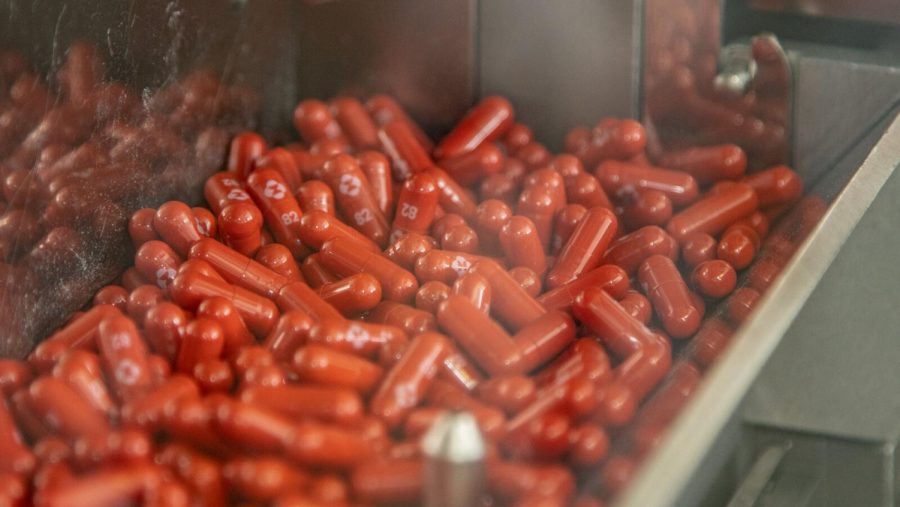COVID pill promises possibility
November 2, 2021
In India, hundreds of people wearily wait in line in hopes of obtaining a COVID vaccine. At a nearby hospital, hallways overflow with patients on respirators.
In the U.S., a sign outside a pharmacy offers COVID vaccines. There is no one waiting in line. One person walks in and requests a shot.
COVID severely impacted our world. It disrupted all aspects of our society and shrouded the future in a cloud of uncertainty. The vaccines have been critical instruments in the dissipation of this cloud. We are just beginning to see the light pierce through. However, this relief may only extend to the Western world. India is battling a deadly second wave of the virus. While the crisis is easing, India still lacks the infrastructure to facilitate a universal vaccine rollout, and only a tiny portion of their population is fully vaccinated. The nation is primed for another potential disaster.
Yet, new developments might bring calm to this impending storm. Merck, a U.S.-based pharmaceutical company, recently announced the development of a promising antiviral drug called Molnupiravir. Molnupiravir is a nucleoside analog, which means it mimics some of the building blocks of RNA, the blueprints viruses use to replicate genomes (genetic material). Therefore, when the compound invades the virus’s cells, it is mistakenly incorporated into its RNA strands.
Touching back to biology, what happens when DNA or RNA base pairs are missing or don’t match up correctly? You guessed it! Mutations.
This drug doesn’t just affect one base pair. It affects countless. When numerous mutations occur, the viral population collapses; the virus mutates until it can no longer function.
What is special about this drug? What makes Molnupiravir so alluring is that it is a pill and can therefore be prescribed and handed out at pharmacies. India cannot connect all of its population to hospitals or clinics, let alone those trained to administer vaccines. However, India can supply and sell medication through pharmacies to a large sector of its population. On this line of benefits, Merck also claims this treatment could reduce mild COVID case hospitalizations by 50% and significantly reduce the chances of person-to-person transmission.
What are its disadvantages? The pill is still in the early stages of development, having yet to complete regulated medical trials. Additionally, two independent Indian firms unofficially ran a trial and observed no benefits. Merck contends this performance is not indicative of the drug’s ability. Perhaps most concerningly, there are worries surrounding the drug’s potential mutative effect on human cells. Although Merck has maintained a constant assurance of the pill’s safety, no data has been published surrounding it.
And even if the drug makes it past these challenges and into the market, Molnupiravir’s cost barrier poses a challenge for India. Although India does have a history of offering cheaper pharmaceuticals, Molnupiravir could be priced exuberantly, leaving the nation unable to reap its benefits.
Regardless of the present issues, an oral COVID treatment would be a huge advancement for the world itself and a testament to humanity’s ability to innovate. Historically, antivirals have been difficult to create, often taking decades of research. The fact that Merck was able to develop a treatment within two years illustrates humanity’s continued growth in the medical sphere. Antiviral treatments for HIV and rabies have saved or extended thousands, if not millions, of lives. The prospect that the world’s deadliest viruses could be rendered harmless or treatable in a matter of a year (given enough focus) is incredible.
To end, I want to emphasize the “given enough focus” stipulation. Why did COVID get such focus? It affected everyone. If it only affected India, would there have been the same push and innovation? I would argue not.
Viral threats are nearly nonexistent across the Western world now, but what about elsewhere? HIV infections in America are negligible in comparison to countries like Ethiopia. Nine thousand Americans contracted tuberculosis in 2016, while nearly 120,000 cases were confirmed in Kenya. Global inequality in medical treatment has been an ever-present condition throughout history. One possible silver lining of COVID is this disparity could be brought to light.
It is now up to the global community to respond and, with time, correct the disparity. There will be another pandemic. If we do not remedy this issue now, who’s to say what will happen in the future? Could the world cope with losing a 10th of its population? Could you sleep soundly at night knowing that there is more that we could have done?
Sources: Nature, India Today, New York Times

